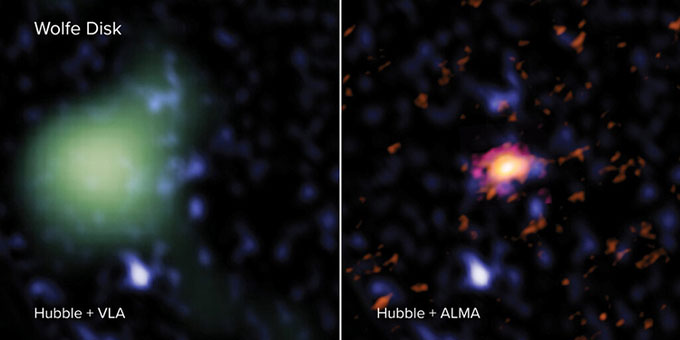Astronomers observe a disc-shaped galaxy 12.5 billion light years from Earth since the very beginning of the universe.
In a universe 13.8 billion years old, most galaxies form gradually over billions of years and reach their current size relatively late. Our Milky Way, for example, has experienced a series of mergers in the first 6 billion years since the Big Bang.
However, a new discovery made at the largest Large Millimiter / Submillimeter Array (ALMA) radio observatory in Atacama, Chile has “distorted” traditional models of galaxy formation. In a May 20 Nature journal article, astronomers said they found a giant disk-shaped galaxy called Galaxy DLA0817g or Wolfe Disk, formed in the early days of the universe.
“With the help of ALMA, we now have clear evidence that the Galaxy DLA0817g existed approximately 1.5 billion years after the Big Bang,” said lead researcher Marcel Neeleman of the Max Astronomical Institute. Planck in Heidelberg, Germany. It is the oldest and most distant disk-shaped galaxy ever known.
The Galaxy DLA0817g is approximately 12.5 billion light years from Earth and 72 billion times heavier than our Sun. ALMA’s observations show it spins at speeds of up to 272 km per second, similar to the Milky Way.

“Most of the ancient galaxies we find in the universe form after violent mergers between small galaxies and hot air masses. It is literally a mess. Does not create the cold, orderly spinning discs we see on the planet. Galaxy DLA0817g “, explains Neeleman of the unusual origins of the new galaxy.
Based on computer simulations, the team suggests that a huge network of dark matter in the early universe could facilitate the formation of cold galaxies.
“We believe that Wolfe Disk evolved primarily through the steady accumulation of cold gas through the dark matter network. But the question is how such a mass of gas is created while remaining the same.” A spinning disc is relatively stable, “he adds. Neeleman.
Neeleman and his colleagues stumbled across the Galaxy DLA0817g when examining light from a quasar or quasar (the object was extremely distant and bright, with a characteristic red lag). Light from the quasar is absorbed as it passes through a giant “reservoir” of hydrogen gas that surrounds the galaxy. This is the indirect way for astronomers to know the existence of a weak galaxy.
“This observation shows how our understanding of the universe is enhanced with the advanced sensitivity provided by the ALMA radio telescope,” said Joe Pesce, director of the astronomy program at the Faculty Foundation. American National School, the sponsor of the ALMA project pointed out. “The device allows us to make new discoveries and most of the sightings are unexpected.”


